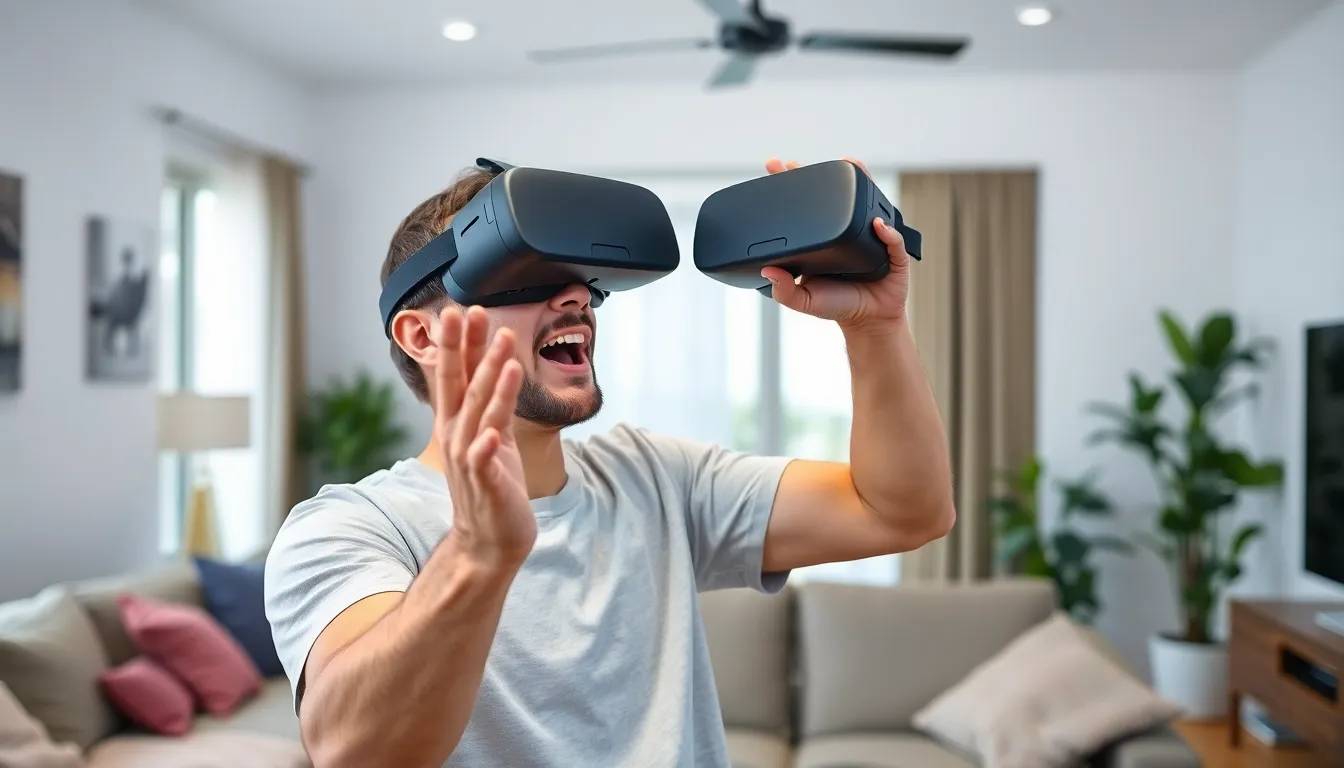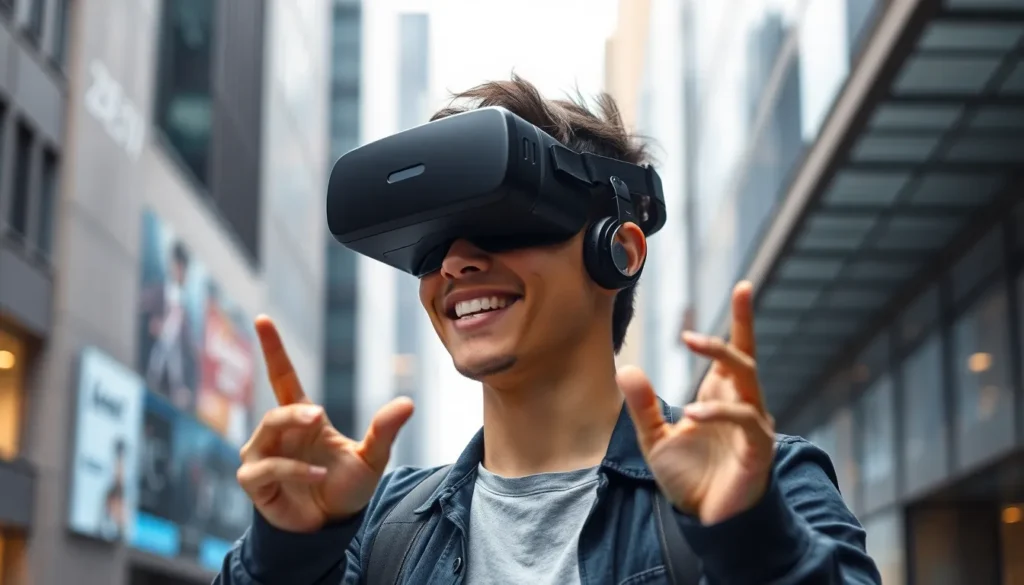Table of Contents
ToggleVirtual reality has transformed the way people interact with technology, bridging the gap between the digital and physical worlds. VR-linked devices are at the forefront of this revolution, offering immersive experiences that engage users like never before. From gaming to education and healthcare, these devices are reshaping how individuals perceive and interact with their environments.
As VR technology evolves, so do the devices that support it. Headsets, gloves, and haptic feedback systems are just a few examples of how innovation is enhancing user experiences. Understanding the capabilities and applications of VR-linked devices is crucial for anyone looking to explore this dynamic landscape. Whether for entertainment or professional use, these tools are paving the way for a new era of interaction.
Overview of VR-Linked Devices
VR-linked devices refer to hardware that integrates virtual reality technology to offer immersive experiences. These devices play a crucial role across diverse fields.
Types of VR-Linked Devices
- VR Headsets
VR headsets serve as the primary entry point for users into virtual environments. Popular models include the Oculus Quest 2, HTC Vive Pro, and PlayStation VR.
- Haptic Feedback Devices
Haptic feedback devices, such as gloves and vests, simulate touch sensations. They enhance immersion by providing tactile responses in virtual settings. Examples include the HaptX Gloves and the bHaptics TactSuit.
- Motion Controllers
Motion controllers allow users to interact with virtual environments. Devices like the Oculus Touch and Valve Index Controllers track hand movements for precise control within VR experiences.
- Tracking Systems
Tracking systems, such as external sensors and cameras, ensure user movements translate accurately in virtual spaces. Configurations can include the HTC Vive Base Stations or external cameras used with the Oculus Rift.
Applications of VR-Linked Devices
- Gaming
VR-linked devices energize the gaming industry, creating interactive worlds that enhance player engagement. Popular titles include Beat Saber and Half-Life: Alyx.
- Education
Educational settings leverage VR for immersive learning experiences. Platforms like Engage and ClassVR provide virtual classrooms for students to explore complex subjects.
- Healthcare
Healthcare providers utilize VR for simulation training and therapy. Applications include surgical simulations and exposure therapy for patients with PTSD.
- Military Training
Military organizations adopt VR-linked devices for realistic training scenarios. Simulators enable soldiers to practice skills in safe, controlled environments without physical risks.
Understanding these devices and their applications reveals the expansive potential of virtual reality in transforming user interaction across multiple sectors.
Types of VR-Linked Devices

Various VR-linked devices enhance user experiences and facilitate interaction in virtual environments. This section highlights key categories, focusing on head-mounted displays and tracking devices.
Head-Mounted Displays
Head-mounted displays (HMDs) serve as the primary interface for experiencing virtual reality. These devices feature high-resolution screens that immerse users in digital environments. Popular examples include the Oculus Quest 2 and HTC Vive Pro, both known for their quality and accessibility. HMDs come equipped with built-in audio systems to provide spatial sound, further enhancing immersion. Additionally, advancements in display technology have led to reduced latency and improved field of view, significantly contributing to user comfort and experience.
Tracking Devices
Tracking devices play a crucial role in accurately translating user movements into virtual spaces. These devices utilize sensors and cameras to capture movement data, enabling real-time interaction. Types of tracking devices include external sensors, such as the Lighthouse system used by HTC Vive, and inside-out tracking integrated into devices like Oculus Quest. Tracking systems can monitor head and body movements, ensuring users experience seamless transitions within virtual environments. Enhanced tracking technologies improve user satisfaction by creating precise spatial awareness and reducing motion sickness, resulting in a more engaging VR experience.
Applications of VR-Linked Devices
VR-linked devices have significant applications across multiple sectors. They enhance user experiences by providing immersive and interactive environments.
Gaming
VR-linked devices revolutionize gaming by creating realistic and immersive worlds. Players engage with popular titles like Beat Saber and Half-Life: Alyx, utilizing motion controllers for precise interactions. Enhanced sensory feedback from haptic devices elevates immersion, allowing players to feel in-game actions. Multiplayer experiences benefit from these technologies, fostering social interactions within virtual environments. The integration of VR in gaming continues to expand, with new genres emerging and existing ones evolving.
Training and Simulation
VR-linked devices play a crucial role in training and simulation across various fields. Healthcare professionals use VR for surgical simulations, allowing for hands-on practice in a safe environment. Military organizations employ VR to train soldiers, simulating combat scenarios without real-world risks. Industries such as aviation utilize VR for pilot training, providing realistic flight experiences while minimizing costs. By offering practical training solutions, VR-linked devices improve skills development and knowledge retention significantly.
Advantages of VR-Linked Devices
VR-linked devices provide numerous benefits across various sectors, enhancing both user experience and functionality.
Enhanced Immersion
VR-linked devices enable users to engage in lifelike environments, fostering deeper emotional connections. HMDs, such as the Oculus Quest 2, offer high-resolution visuals that contribute to this immersive experience. Realistic auditory feedback from integrated audio systems further amplifies the sense of presence.
Improved Learning Outcomes
VR enhances learning through interactive simulations. Educational platforms like Engage allow students to visualize complex concepts, promoting better retention. Studies show that learners using VR linked devices demonstrate a higher understanding of the subject matter compared to traditional methods.
Increased Training Efficiency
VR-linked devices streamline training processes across sectors such as healthcare and aviation. Medical professionals practice surgical procedures through VR simulations, reducing the risks associated with traditional training. Military personnel refine skills in realistic scenarios, enhancing preparedness while maintaining safety.
Greater Accessibility
VR technology democratizes access to experiences. Individuals with physical limitations can explore environments virtually, removing barriers to travel or participation in activities. This inclusivity opens new avenues for those previously unable to engage in certain experiences.
Enhanced Social Interaction
VR-linked devices foster social connections in virtual environments. Multiplayer games and educational platforms enable users to interact with peers, promoting collaboration and teamwork. This social aspect enriches user experiences, making VR not just a solitary activity but a communal one.
Versatile Applications
VR-linked devices adapt to various industries, including gaming, education, and healthcare. Their versatility allows developers to create tailored experiences, addressing specific needs while pushing the boundaries of creativity. From gaming worlds to training simulations, the potential applications are nearly limitless.
Challenges and Limitations
VR-linked devices face several challenges and limitations that can impact user experience and overall effectiveness. Identifying these issues is crucial for advancements in the technology.
- Cost Barriers: High prices of VR systems, including headsets and peripherals, limit accessibility for many users. Premium devices can cost upwards of $1,000, creating financial constraints for consumers and organizations.
- Physical Discomfort: Users often experience discomfort during prolonged use of VR-linked devices. Symptoms such as motion sickness and eye strain can arise due to discrepancies between visual stimuli and physical movement.
- Limited Content Availability: A shortage of high-quality, immersive content restricts user engagement. Despite advancements, the library of VR applications and experiences remains smaller compared to traditional gaming and media platforms.
- Technical Limitations: Some VR devices struggle with issues related to resolution, refresh rates, and tracking accuracy. Subpar performance can detract from the immersive experience, causing frustration among users.
- User Space Requirements: VR experiences necessitate adequate physical space for safe movement. Many users face constraints in their environments, limiting their ability to fully engage with VR applications.
- Social Isolation Risks: Heavy immersion in VR may lead to social isolation, as individuals can become engrossed in virtual environments at the expense of real-world interactions. Striking a balance between virtual and physical experiences is essential.
- Data Privacy Concerns: As VR devices collect extensive user data, concerns about privacy and security increase. Protecting sensitive information from potential breaches poses significant challenges for developers and manufacturers.
- Initial Learning Curve: Users often face a learning curve when first interacting with VR devices. Familiarization with controls and interactions may hinder immediate enjoyment, requiring additional time for users to adapt.
Understanding these challenges can facilitate improvements in VR technology, paving the way for enhanced user experiences and broader acceptance across various sectors.
The rise of VR-linked devices marks a pivotal moment in technology and user interaction. Their ability to create immersive experiences is reshaping industries from gaming to healthcare. As these devices continue to evolve they promise even greater engagement and accessibility.
While challenges like cost and physical discomfort remain significant the potential benefits far outweigh the drawbacks. By addressing these issues the future of VR technology looks bright. Ongoing advancements will likely lead to broader acceptance and innovative applications across diverse fields.
Ultimately VR-linked devices are not just enhancing existing experiences but are paving the way for entirely new ways to learn interact and connect.







